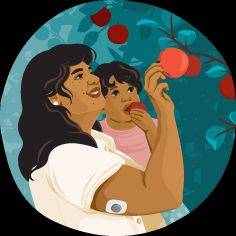Early symptoms of diabetes include extreme thirst, a frequent need to pee, and unintentional weight loss. Visit a doctor for a diagnosis if you are experiencing any of these symptoms.
Diabetes is a serious, common health condition. If you have diabetes, you need to manage and regularly monitor your glucose (blood sugar) levels to be sure they’re within a target range.
There are two main types of diabetes: type 1 and type 2.
Type 1 diabetes is a chronic autoimmune condition usually diagnosed in childhood or adolescence.
Type 2 diabetes typically develops in adulthood. It occurs when your body stops responding to insulin, a hormone produced by your pancreas, that helps your cells take in sugar from your blood.
The only way to know for sure that you have diabetes is to get tested. The most common tests are the A1C test and the plasma glucose test.
This article takes a closer look at the early signs and symptoms of type 1 and type 2 diabetes, testing options, and treatments.
Untreated diabetes tends to cause worsening symptoms over time as chronically high blood sugar levels cause more damage to your tissues and organs. You may not recognize these symptoms in the beginning if they’re mild.
The symptoms of type 2 diabetes tend to come on more gradually than type 1 diabetes. In the early stages of diabetes, there may be no symptoms at all.
It’s important to visit a doctor if you notice any potential symptoms of diabetes. If left untreated, diabetes can severely damage the tissues and organs in your body.
Early symptoms
Type 1 and type 2 diabetes have some symptoms that are the same and some that are different.
The
- extreme thirst
- frequent urination, especially at night
- unintentional weight loss
- increased hunger
- blurred vision
- numbness or tingling in your hands and feet
- fatigue
- skin that’s very itchy or dry
- wounds that don’t heal quickly
Type 1 diabetes symptoms can develop quickly, within a
It’s generally diagnosed in children and young adults, although it can occur at any age. It’s
In addition to the symptoms outlined in the previous section, a child may experience additional symptoms such as:
- sudden, unintentional weight loss
- wetting the bed after a history of being dry at night
- a yeast infection in a prepubescent girl
- breath that smells like fruit
- flu-like symptoms, including:
- nausea
- vomiting
- problems breathing
- loss of consciousness
Flu-like symptoms occur when undiagnosed diabetes causes ketones to build up in the bloodstream. This condition is called diabetic ketoacidosis. It’s a medical emergency and requires immediate medical treatment.
Symptoms of type 2 diabetes tend to come on more gradually than type 1 diabetes.
Type 2 diabetes can develop over
Instead, you may receive a diabetes diagnosis after visiting the doctor for:
- persistent infections or a slow-healing wound
- numbness or tingling in your hands or feet
- heart problems
People with type 2 diabetes have an increased risk of developing certain health problems, which can also be symptoms of diabetes.
Let’s take a closer look at each of these issues in more detail.
Hunger, thirst, and fatigue
Many people with type 2 diabetes experience hunger and fatigue due to their body’s inability to metabolize the glucose in their blood.
Your kidneys need to work harder to get rid of excess sugar in your blood, which can cause frequent urination and thirst.
Immunosuppression and infections
Chronically high levels of blood sugar can cause dysfunction of the immune system.
People with type 2 diabetes have an increased risk of developing infectious diseases. Yeast infections are particularly common in people with diabetes.
A
Diabetic neuropathy
Diabetic neuropathy is a potentially serious complication of type 2 diabetes.
Diabetic neuropathy is nerve damage caused by chronically high blood sugar levels. Early symptoms include tingling, pain, or weakness in your hands and feet.
As it progresses, diabetic neuropathy may cause pain in your extremities, which increases the risk of developing conditions such as diabetic ulcers.
Blurry vision
Blurry vision can be one of the first symptoms of diabetes.
High levels of glucose in your eyes can cause the lens in your eyes to swell and distort your vision. Over time, elevated glucose levels can also damage your retina and the nerves that play a key role in your vision.
Sudden blurry vision can also occur from a sudden drop in your blood sugar. Additionally, diabetes increases your risk of developing other eye conditions that can cause blurred vision, such as glaucoma.
There are certain risk factors for both type 1 and type 2 diabetes. This isn’t an exhaustive list, and even adults can develop type 1 diabetes, though it’s rare.
| Type | Risk factors |
|---|---|
| type 1 | • younger age (children and adolescents) • an |
| type 2 | • middle age (45 years old and over) • overweight or obesity • low physical activity levels • smoking • family history of diabetes • high blood pressure • abnormal triglyceride or HDL (good) cholesterol levels • history of insulin resistance • certain ethnic backgrounds, such as American Indian, Alaskan Native, Hispanic, or Black |
Many people get tested for diabetes because they develop symptoms that are potential early signs.
For example, people with type 1 diabetes may experience unintentional weight loss or develop flu-like symptoms. People with type 2 diabetes may experience extreme thirst or frequent urination.
You may experience one or more of the early symptoms associated with diabetes. If you do, it’s important to contact your doctor for an appointment.
You may also receive a diabetes diagnosis after visiting your doctor for another condition or routine blood work.
If you make an appointment with your doctor due to diabetes warning signs, they will want to know:
- your symptoms
- family history
- medications you’re taking
- any allergies you have
Your doctor will ask you questions about your symptoms and will likely run some blood tests.
There are several tests that can diagnose diabetes. These include:
- A1C: This test shows what your blood glucose level has averaged for the last 2 or 3 months. This does not require you to fast or drink anything.
- Fasting plasma glucose: You will need to fast for at least 8 hours before this test.
- Oral glucose tolerance: This test takes 2 to 3 hours. Your blood glucose levels are tested initially and then repeated at intervals for 2 hours after you’ve consumed a specific sweet drink.
- Random plasma glucose test: You can have this test done anytime and do not need to fast.
It’s also helpful to have a list of questions to ask your doctor regarding your symptoms and any concerns you have about other health conditions.
Diabetes has several treatments. Diet, physical activity, and careful monitoring are important if you have diabetes, no matter which type of diabetes you have.
If you have type 1 diabetes, you will need to take insulin for the rest of your life. That’s because your pancreas doesn’t produce the insulin your body needs.
If you have type 2 diabetes, it may be possible to manage your diabetes with lifestyle changes, such as diet, weight loss, and physical activity. You may also need to take oral or injectable medications, including insulin or metformin, to manage your blood sugar levels.
If you have either type 1 or type 2 diabetes, you’ll need to carefully track your diet to prevent your blood sugar levels from getting too high. This generally means watching your carbohydrate intake as well as limiting over-processed, low fiber foods, such as:
- sugary sodas
- sweetened breakfast cereals
- white bread
- white pasta
- white rice
- fruit juices
- processed, packaged snacks
- fruit-flavored yogurt
- flavored coffee drinks
Your doctor will work closely with you to develop a treatment plan to help you manage your blood sugar levels.
If you have type 1 diabetes, you’ll need to manage your glucose levels by matching your insulin to your diet and activity.
If you have type 2 diabetes, you may be able to manage your blood sugar levels with diet and activity alone. If lifestyle changes don’t help bring down your blood sugar levels to a healthy range, your doctor will work with you to add medications as needed.
Diabetes is a progressive disease that may require reevaluation and changes to your treatment plan over time.
You can live a full and active life with diabetes. Although diabetes requires careful planning and management, it shouldn’t prevent you from doing and enjoying everyday activities.
Type 1 diabetes can’t be prevented.
You may be able to reduce your risk of type 2 diabetes by managing your weight, staying active, and following a balanced diet. However, genetics and other risk factors may increase your risk despite your best efforts.
If you have any risk factors for diabetes, it’s important to get regular checkups with a doctor or other healthcare professional. This will help prevent diabetes from progressing and causing other serious health complications.
Type 1 diabetes is usually diagnosed in childhood, but you can develop it at any age. Early symptoms often include unintentional weight loss, bedwetting, and flu-like symptoms.
Type 2 diabetes is more likely to be diagnosed in adulthood, but young people and children
Often, symptoms of untreated diabetes get worse and are either mild or unnoticeable in the early stages. A diabetes diagnosis can be confirmed with one or more blood tests.
Talk with a doctor if you believe you have diabetes. Getting on top of your condition and managing it effectively is key to relieving your symptoms and preventing more serious health problems.






